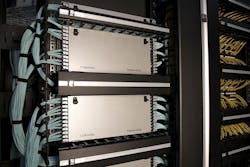Keys to Effective Fiber Optic Cable Installation
Duke Robertson, from Chatsworth Products shares a few best practices for fiber optic cable installation in your data center.
Duke Robertson, Product Manager – Open Systems, Chatsworth Products
The National Electric Contractors Association (NECA), along with the Fiber Optic Association (FOA) jointly developed the NECA/FOA 301-2009 Standard for Installing and Testing Fiber Optics, which addresses the emergent demands that fiber optic cables present in technology environments. The Safety and Installation sections of the NECA/FOA 301-2009 use Occupational Safety and Health Administration (OSHA) and National Electric Code (NEC) regulations to address the proper handling of fiber optic cables during installation and maintenance.
If you are considering using fiber optic cables in your data center, take a moment to review a selection of these procedures:
Before Installation:
- Allow for future growth in the quantity and size of cables when determining the size of the pathway bend radius requirements.
- Try to complete the installation in one pull. Prior to any installation, assess the route carefully to determine the methods of installation and obstacles likely to be encountered.
Optical Fiber Cables are more susceptible to damage during the stress of installation, therefore there are two specifications for bend radii—Bend Radii before installation and Bend Radii after installation. See the table below for estimating proper bend radii:
| Use | Pulling | At Rest |
| To Work Area (1 to 4 Strands) | 2” (50 mm) inch radius | 1” (25 mm) radius |
| Inside plant | 15 times OD | 10 times OD |
| Outside Plant | 20 times OD | 10 times OD |
Source: EIA/TIA 568 Standard for Fiber Optics
Deploying Effective Vertical Cable Runs:
- Check the cable length to make sure the cable being pulled is long enough for the run.
- When laying loops of fiber on a surface during a pull, use “figure-8” loops to prevent twisting the cable.
- All hardware and support structures should follow the recommendations of TIA-569 and NECA/BICSI 568 Standards documents.
- Do not exceed the cable bend radius. Fiber optic cable can be broken when kinked or bent too tightly, especially during pulling.
- Drop vertical cables down rather than pulling them up.
- Support cables at frequent intervals to prevent excess stress on the cable jackets.
- Use cable management straps or cable ties to support cable bundles. Make sure these implements are fastened snugly, but not tightly around cable bundles.
Protecting Cables and Equipment from Fiber Residue
- Small scraps of bare fiber produced as part of the termination and splicing process must be properly disposed in a safe container. Follow your local regulations – in some areas this material may be considered hazardous waste.
- Thoroughly clean the work area when finished; do not use compressed air to clean off the work area.
- The small size of optical fibers makes them very sensitive to dust and dirt. Maintain the highest standards of cleanliness when working with fiber to optimize its performance.
Fiber Optics, Electrical Safety and Proper Grounding and Bonding
- Though fiber optic cables are generally all-dielectric, power should be disconnected for the duration of the installation process when working in areas that have installed electrical hardware and power cables.
- Fusion splicers create an electric arc. Ensure that there are no flammable vapors and/or liquids present. Do not use in confined spaces as defined by OSHA.
- Although most fiber optic cables are non-conductive, any metallic hardware used in fiber optic cabling systems (such as wall-mounted termination boxes, racks and patch panels) must be grounded.
In summary, installing a fiber optic cable system goes beyond cable management and connecting two points together. Due to the unique properties of fiber cabling, it is crucial to look for manufacturers that provide high quality, adaptable and dependable solutions that meet the latest industry standards.
Submitted by Duke Robertson, Product Manager – Open Systems, Chatsworth Products (CPI). Duke joined CPI in December 2007 and has more than 20 years of experience in a broad range of disciplines including design, manufacturing, product management and product development. In his role at CPI, Duke focuses on developing tailored solutions for customer-specific applications, utilizing CPI’s unique and extensive design and manufacturing capabilities.
Chatsworth Products (CPI) mission is to address today’s critical IT infrastructure needs with products and services that protect your ever-growing investment in information and communication technology. CPI acts as your business partner and is prepared to respond to your specific requirements with global availability and rapid product customization that will give you a competitive advantage.

